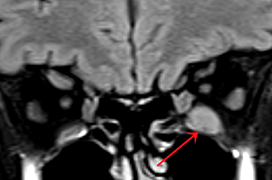The purpose is to acquaint readers with the contribution of imaging methods (IMs) of the orbit, specifically computed tomography (CT) and magnetic resonance imaging (MRI), in the diagnosis of thyroid-associated orbitopathy (TAO).
Methods: IMs of the orbit are an indispensable accessory in the clinical and laboratory examination of TAO patients. The most frequently used and probably most accessible method is an ultrasound examination of the orbit (US), which, however, has a number of limitations. Other methods are CT and MRI. Based on the published knowledge implemented in our practice and several years of experience with the diagnosis and treatment of TAO patients, we would like to point out the benefits of CT and MRI in the given indications: visualisation of the extraocular muscles, assessment of disease activity, diagnosis of dysthyroid optic neuropathy and differential diagnosis of other pathologies in the orbit. Our recommendation for an ideal MRI protocol for disease activity evaluation is also included.
Conclusion: IMs play an irreplaceable role not only in the early diagnosis of TAO, but also in the monitoring of the disease and the response to the applied treatment. When choosing a suitable IM for this diagnosis, a number of factors must always be taken into account; not only availability, cost and burden for the patient, but especially the sensitivity and specificity of the given method for the diagnosis of TAO.

